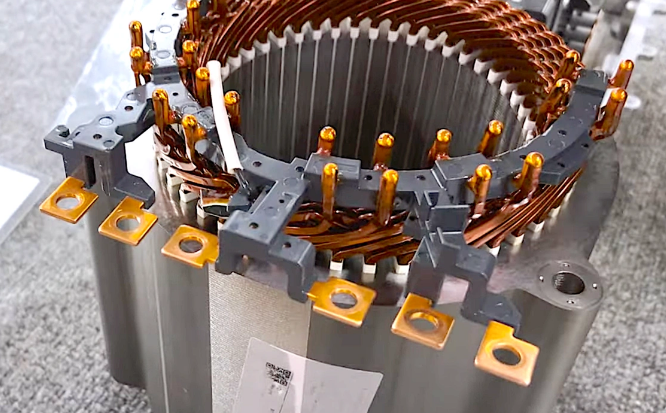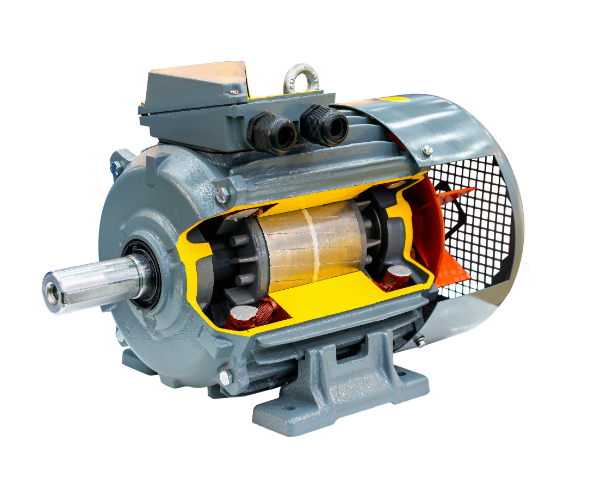The formula for calculating the output power of a three-phase motor is P = √3 × U × I × cosφ. As seen from the above formula, for a voltage of 400 volts, a current of 10 amps, and a power factor of 0.85, the output power is around 5.9 kW. Needless to say, precise measurement of voltage and current is important.
The relationship between current, voltage, and power
The relationship between current and voltage is the major factor affecting the power output in a three-phase motor. In general, the formula for calculating power in motors is: P = √3 × U × I × cosφ, where P is the active power of the motor in kilowatts; U is the line voltage of the motor in volts; I is the current in amperes; and cosφ is the power factor. For instance, a three-phase motor rated at 400 volts, 10 amps, and a power factor of 0.85 can have an approximate output given by the formula:
P = 1.732 × 400 × 10 × 0.85 ≈ 5.9 kW.
In other words, this motor should be able to provide 5.9 kW of power, enough to run several industrial devices. Any fluctuation in current or voltage will automatically vary the power output of the motor. For example, if the current increases to 12 amps, the power will rise to approximately 7.08 kW, an increase of roughly 20%. The power factor, cosφ, is also usually optimized in most industrial applications. If the power factor of a motor in a factory increases from 0.75 to 0.90, the real output power of this motor will increase by approximately 20%, which reduces power loss and lowers electricity costs. To accurately measure the power output of a three-phase motor, the current and voltage should be stable. Unstable voltage will cause unstable power output of the motor and potentially affect production efficiency. For example, when there is a drop in voltage of 10%, the power output of the motor is reduced by 15%-20%, thereby reducing the efficiency of the equipment.

Practical tips from professionals
Many professionals prefer the use of a power analyzer to measure the three-phase power of a motor. This device directly measures voltage, current, and phase difference, allowing it to present power data quickly and accurately. The most common power analyzers on the market range from $500 to $5000; more comprehensive features and higher measurement accuracy correspond to higher prices. Another recommendation by experts is regular calibration of measuring instruments. Even the most advanced instrument can develop measurement errors over time. According to the recommendations by the International Electrotechnical Commission (IEC), it is advised to perform calibration for power analyzers every two years to ensure accuracy. Large manufacturing companies normally budget in the range of $2,000 to $5,000 annually for instrument calibration.
Many technicians and engineers use a Variable Frequency Drive (VFD) in practice to vary the speed of the motor and the power applied, serving as a means of modifying the motor’s energy consumption. As such, it increases the motor’s efficiency and lowers the equipment’s energy consumption. To improve the power factor, installing a Static Var Compensator (SVC) is the best option for companies. An SVC can dynamically adjust the reactive power in the grid to stabilize the motor power output. The Bosch factory in Germany installed several SVC systems, saving over €200,000 in electricity every year. Another professional tip involves understanding the concept of the power factor: the power factor, cosφ, is defined as the ratio between real power and apparent power of the motor. The closer this power factor is to 1, the better the efficiency of the motor. For example, one textile company was able to enhance the power factor of its motor from 0.75 up to 0.95, increasing the power output by almost 27%. Not only was the consumption of electricity reduced, but it also eased the burden on the power grid.
Key factors affecting accuracy
The accuracy of the output power calculation for three-phase motors depends upon measurement errors in current, voltage, and power factor. The measurement errors of the voltmeter and ammeter will directly determine the accuracy of the calculation result. According to industry standards, the measurement error must not be greater than ±1%; otherwise, the power output computation error can exceed 10%. Voltage fluctuations are the most common factor that influences power calculations. If the voltage fluctuates beyond ±5% of the rated value, the actual output power of the motor will change by 5%-15%. A motor with a rated power of 50 kW may only output 47.5 kW or less if the voltage drops by 5%, which directly influences production efficiency.
Power factor fluctuations also affect the accuracy of power calculation. Loading conditions usually determine the power factor, and thus fluctuations can cause the power factor to vary between 0.7 and 1. The output power decreases by about 11% when the power factor drops from 0.9 to 0.8, and this decrease directly affects equipment efficiency. Companies experiencing fluctuations often use capacitor banks to maintain the power factor and avoid production losses. Another factor that must be taken into consideration is harmonic distortion. Harmonics are components in current or voltage waveforms beyond the fundamental wave. This condition is quite common in factories with a large number of variable frequency drives or nonlinear loads. If the Total Harmonic Distortion (THD) goes above 5%, the effective power to the motor falls significantly. Again, the wiring method selected influences the accuracy of the measurement. Current and voltage distribution, and hence power calculation, vary depending on whether delta or star wiring configurations are used in various applications. In this respect, high-power applications use delta wiring, while star wiring has a broad application in low-power settings. A machining factory changed the wiring configuration of its motor from delta to star and witnessed a 10% enhancement in output efficiency, resulting in savings of about 8% per year in electricity costs.

Common errors in practical applications
Several error factors commonly occur in practical applications involving three-phase motors, particularly in power calculation. The first is error in current measurement, which commonly happens in large industrial equipment; measurement errors normally result from insufficient sensitivity of the sensor or from aging equipment. For example, assuming the use of an 800 kW motor in industrial production, a 5% current measurement error would result in over a 40 kW deviation in the actual output power, equating to consuming 20 more kWh per hour and increasing the annual power cost by tens of thousands of dollars. Another major factor affecting the accuracy of power calculation is fluctuation in voltage. Voltage fluctuations are generally caused by an unstable grid or internal power distribution system faults. If the voltage fluctuates more than ±10%, the actual output power of the motor can fluctuate by as much as 15%-25%.
Wiring errors are among the most frequently encountered sources of errors in practical applications. Wiring for three-phase motors is mainly based on star and delta wiring configurations. If the wiring method is not appropriate, the actual power consumption of the motor will be far from the theoretical value. The aging of equipment may result in a decline in insulation performance for the motor, increased current leakage, and reduced actual power output compared to expectations. Another common source of mistakes in practical applications is environmental influence. A high-temperature, humid, or dusty environment will affect the operating condition of the motor and lead to unstable power output. For example, one textile factory found that during high-temperature summer periods, the power output of its motors decreased by 8%-10%, which meant production efficiency decreased by 5% accordingly.








